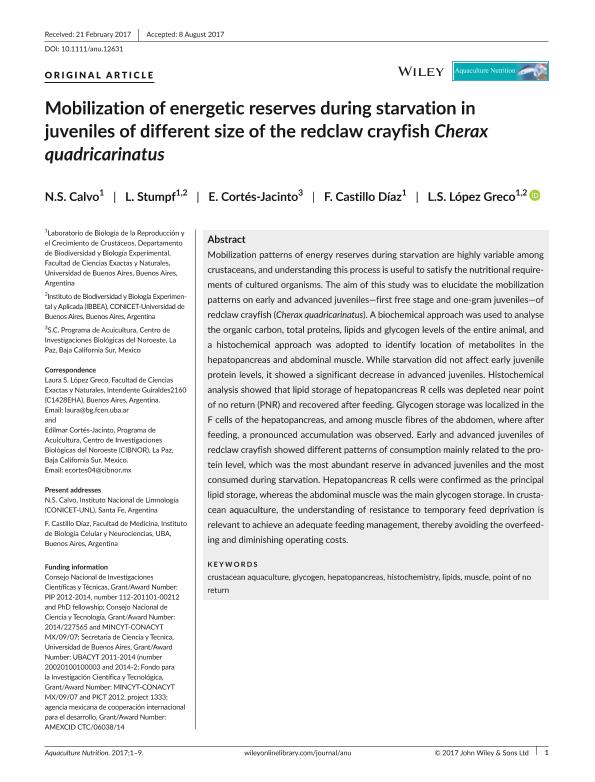Artículo
Mobilization of energetic reserves during starvation in juveniles of different size of the redclaw crayfish Cherax quadricarinatus
Calvo, Natalia Soledad ; Stumpf, Liane
; Stumpf, Liane ; Cortés Jacinto, E.; Castillo Díaz, Fernando
; Cortés Jacinto, E.; Castillo Díaz, Fernando ; Lopez, Laura Susana
; Lopez, Laura Susana
 ; Stumpf, Liane
; Stumpf, Liane ; Cortés Jacinto, E.; Castillo Díaz, Fernando
; Cortés Jacinto, E.; Castillo Díaz, Fernando ; Lopez, Laura Susana
; Lopez, Laura Susana
Fecha de publicación:
06/2018
Editorial:
Wiley Blackwell Publishing, Inc
Revista:
Aquaculture Nutrition
ISSN:
1353-5773
Idioma:
Inglés
Tipo de recurso:
Artículo publicado
Clasificación temática:
Resumen
Mobilization patterns of energy reserves during starvation are highly variable among crustaceans, and understanding this process is useful to satisfy the nutritional requirements of cultured organisms. The aim of this study was to elucidate the mobilization patterns on early and advanced juveniles—first free stage and one-gram juveniles—of redclaw crayfish (Cherax quadricarinatus). A biochemical approach was used to analyse the organic carbon, total proteins, lipids and glycogen levels of the entire animal, and a histochemical approach was adopted to identify location of metabolites in the hepatopancreas and abdominal muscle. While starvation did not affect early juvenile protein levels, it showed a significant decrease in advanced juveniles. Histochemical analysis showed that lipid storage of hepatopancreas R cells was depleted near point of no return (PNR) and recovered after feeding. Glycogen storage was localized in the F cells of the hepatopancreas, and among muscle fibres of the abdomen, where after feeding, a pronounced accumulation was observed. Early and advanced juveniles of redclaw crayfish showed different patterns of consumption mainly related to the protein level, which was the most abundant reserve in advanced juveniles and the most consumed during starvation. Hepatopancreas R cells were confirmed as the principal lipid storage, whereas the abdominal muscle was the main glycogen storage. In crustacean aquaculture, the understanding of resistance to temporary feed deprivation is relevant to achieve an adequate feeding management, thereby avoiding the overfeeding and diminishing operating costs.
Archivos asociados
Licencia
Identificadores
Colecciones
Articulos(IBBEA)
Articulos de INSTITUTO DE BIODIVERSIDAD Y BIOLOGIA EXPERIMENTAL Y APLICADA
Articulos de INSTITUTO DE BIODIVERSIDAD Y BIOLOGIA EXPERIMENTAL Y APLICADA
Citación
Calvo, Natalia Soledad; Stumpf, Liane; Cortés Jacinto, E.; Castillo Díaz, Fernando; Lopez, Laura Susana; Mobilization of energetic reserves during starvation in juveniles of different size of the redclaw crayfish Cherax quadricarinatus; Wiley Blackwell Publishing, Inc; Aquaculture Nutrition; 24; 3; 6-2018; 952-960
Compartir
Altmétricas



